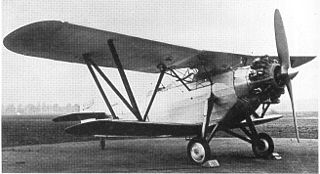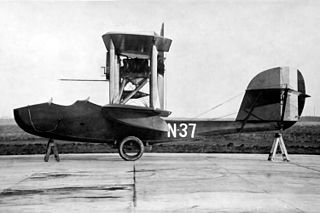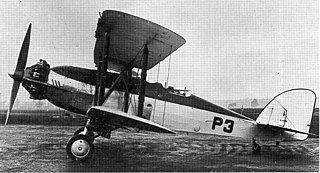
The Hawker Harrier was a British experimental biplane torpedo bomber aircraft built by Hawker Aircraft to a specification issued in the 1920s for the Royal Air Force.
Westland Aircraft was a British aircraft manufacturer located in Yeovil, Somerset. Formed as a separate company by separation from Petters Limited just before the start of the Second World War, Westland had been building aircraft since 1915. During the war the company produced a number of generally unsuccessful designs, but their Lysander would serve as an important liaison aircraft with the Royal Air Force. After the war the company focused on helicopters, and was merged with several other British firms to create Westland Helicopters in 1961.

The Bristol Pegasus is a British nine-cylinder, single-row, air-cooled radial aero engine. Designed by Roy Fedden of the Bristol Aeroplane Company, it was used to power both civil and military aircraft of the 1930s and 1940s. Developed from the earlier Mercury and Jupiter engines, later variants could produce 1,000 horsepower from its capacity of 1,750 cubic inches by use of a geared supercharger.

The Vickers Type 131 Valiant was a British general-purpose biplane produced by Vickers in 1927, with the intention of replacing the Royal Air Force's Airco DH.9As, but was unsuccessful, with only a single example built, which was sold to Chile.

The Hawker P.V.4 was a 1930s British biplane aircraft built by Hawker Aircraft in competition for a government order for a general-purpose military aircraft.

The Hawker Horsley was a British single-engined biplane bomber of the 1920s. It was the last all-wooden aircraft built by Hawker Aircraft, and served as a medium day bomber and torpedo bomber with Britain's Royal Air Force between 1926 and 1935, as well as the navies of Greece and Denmark.

The Westland Wapiti was a British two-seat general-purpose military single-engined biplane of the 1920s. It was designed and built by Westland Aircraft Works to replace the Airco DH.9A in Royal Air Force service.

The Westland Limousine was a 1920s British single-engined four-seat light transport aircraft built by Westland Aircraft.

The Westland Wallace was a British two-seat, general-purpose biplane of the Royal Air Force, developed by Westland as a follow-on to their successful Wapiti. As the last of the interwar general purpose biplanes, it was used by a number of frontline and Auxiliary Air Force Squadrons. Although the pace of aeronautical development caused its rapid replacement in frontline service, its useful life was extended into the Second World War with many being converted into target tugs and wireless trainers. In 1933 a Westland Wallace became the first aircraft to fly over Everest, as part of the Houston-Mount Everest Flight Expedition.
Wings over Everest is a 1934 British short documentary film directed by Geoffrey Barkas and Ivor Montagu. It won an Academy Award in 1936 for Best Short Subject (Novelty). It described the 1933 Houston-Mount Everest flight expedition, in which Douglas Douglas-Hamilton, 14th Duke of Hamilton, otherwise known as Lord Clydesdale, piloted a single-engined biplane on 3 April 1933, just clearing Everest's southern peak by a few feet, having been caught in a powerful downdraught. The film used mixture of real footage of Everest from the record-breaking flight and theatrically produced scenes using the actual people rather than actors.

The Westland Widgeon was a British light aircraft of the 1920s. A single-engined parasol monoplane, the Widgeon was built in small numbers before Westland abandoned production in 1929.

The Parnall G.4/31 was a 1930s design from the George Parnall and Company to meet Air Ministry Specification G.4/31 for a "general purpose" aircraft.

The Short Type 166 was a 1910s British two-seat reconnaissance, bombing and torpedo-carrying folder seaplane, designed by Short Brothers.
The Westland Wagtail was a prototype British fighter aircraft of the First World War. A single-engined tractor biplane, the Wagtail was a failure owing to the unreliability of its engine, only five being built.

The Bristol Type 118 was a general-purpose military aircraft, a two-seat biplane built by the Bristol Aeroplane Company in the early 1930s, powered by a Bristol Mercury radial engine and aimed at overseas markets. The Type 120 was a Bristol Pegasus-engined variant entered into an Air Ministry competition and later used for armament tests. Two aircraft were built.

The Armstrong Whitworth A.W.19 was a two/three-seat single-engine biplane, built as a general-purpose military aircraft in the mid-1930s. A newer, monoplane aircraft was preferred and only one A.W.19 was built.

The Vickers Type 253 was a single-engined two-seat biplane general-purpose military machine, built to a 1930 government specification. It won a production contract, but this was transferred to the same company's monoplane equivalent, the Wellesley. Only one Type 253 was built.

The Norman Thompson N.1B was a prototype British flying boat fighter aircraft of the First World War. A two-seat single-engined pusher biplane, a single example was built in 1917, but no production followed.
The Westland PV.7 was a private venture submission to a 1930s British specification for a general-purpose military aircraft with two crew. It was a single-engined, high-wing monoplane of promise, but was destroyed early in official tests.

The first flight over Mount Everest was undertaken in April 1933 by two Westland aircraft. They were piloted by Douglas Douglas-Hamilton and David McIntyre, with Stewart Blacker and Sidney Bonnett in the observer seats. The expedition was financed by Lucy, Lady Houston and led by Peregrine Fellowes.
















